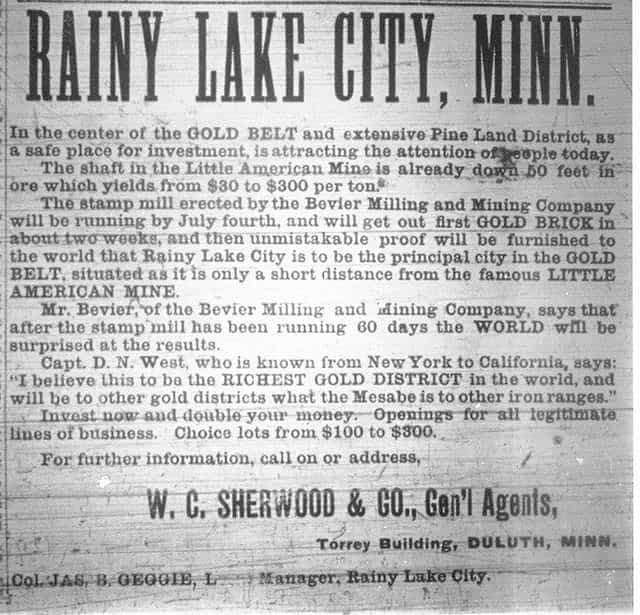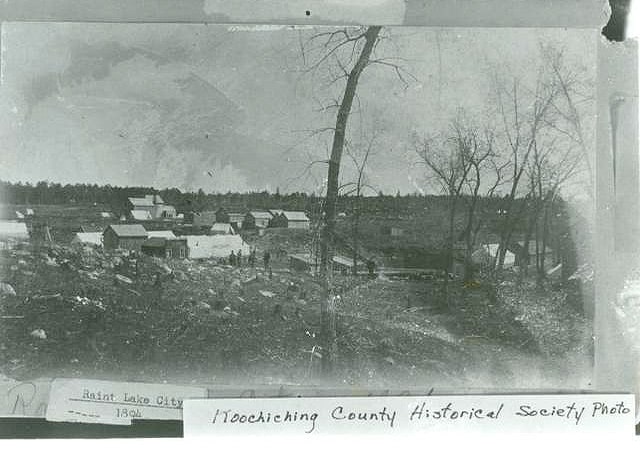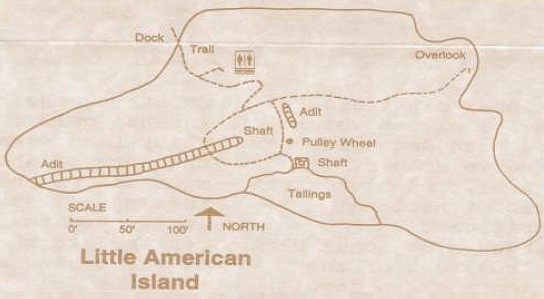Editor’s Note: Whenever possible, Quetico Superior Wilderness News highlights partners committed to protecting or enhancing the wilderness character of the region. The following piece is reposted with permission by the Voyageurs National Park Association.
by Eric Grunwald, National Park Service
It was a calm and warm mid-September day when my friend Jeff and I put our canoe in the water at the Rainy Lake Visitor Center boat ramp. Jeff is a park ranger at Grand Canyon National Park and I was excited to show him the sites of some of the most interesting historic events that took place on Rainy Lake inside what is now Voyageurs National Park. As we paddled away from the boat ramp the North Woods were in all their splendor. A loon dove under the water no more than 50 yards away and an eagle soared overhead. The very first hint of fall color shone on a few of the scattered aspens on the lakeshore.
We made quick time on the calm waters of Black Bay, and before we know it we were at the dock marking the site of Rainy Lake City. Today the city is no more than the grassy trace of an old city street. Though there are two buildings on the site, these buildings do not date from Rainy Lake City, but from a later time in northern Minnesota history. As we docked the canoe and headed into the forest, there seemed to be more going on in Rainy Lake City than met the eye. We talked the trace of what had been one of the town’s streets and I told Jeff a little bit about the town’s history.

In 1894 a small town, perhaps as large as 500 inhabitants, grew at the site where we walked. Rainy Lake City held many of the conveniences that one would expect in a town of the mid-1890s. Very early on in its existence Charles W. Moore wrote that the town has “eight drygoods stores, as many groceries, three hotels and restaurants, two newspapers, one livery barn, three laundries…one doctor and one lawyer.” Perhaps L.D. Chadbourne described the scene at Rainy Lake City best when he wrote in 1894 “the population of Rainy Lake City is 214, eleven of whom are females… there are places where you can get whiskey at 15 cents per small glass; or play any kind of robbers game that you are looking for.” Chadbourne concluded by writing “Every branch of business that is needed in a new town is well represented, especially the saloon business. There are only 16 saloons at present, but the people have faith there are more to follow.” There must have been a wild and transient atmosphere to the town, and just like many of the towns that sprang up overnight in the American West, the reason why Rainy Lake City was developed was to support the mining industry, in this case the only gold mines in Minnesota.
We walked the grassy road trace to the point where it seemed to disappear. Then, we turned around and started to make our way back to the canoe. As we walked, I swear I could almost hear the muted laughter and conversation of men drinking and playing cards. “This must have been quite the place in the 1890s” Jeff said to me as the canoe came into sight. Before we left Rainy Lake City we decided to head into the old log building that’s left unlocked for visitors to explore. I went on to explain to Jef that the building that we were inside does not date from the Rainy Lake Gold Rush of the 1890s, but to a later date, the Prohibition Era of the 1920s. It is what was called a “blind pig” or speakeasy where patrons could get alcohol even though its sale was illegal. It seems even though Rainy Lake City was largely a ghost town by 1901, people were still drawn to the seclusion of the site well into the 20th century.

We got back into the canoe at the dock and started to make our way west on Rainy Lake. We had yet another destination in mind, the only Minnesota gold mine to ever turn a profit on Little American Island. While the winds had been calm on Black Bay, we were less sheltered now that we were on more open water. It is incredible how a wind as light as 5 miles per hour can make paddling more difficult. A few fishing boats passed us as we made our way to the north side of Little American Island and the dock for the trailhead.
Little American Island marks the site where, in 1893, prospector George W Davis gouged out a sample of quartz from a vein on the island. The quartz sample was send to Duluth to be assayed, or tested for gold, and sure enough the test showed an average of about $98 worth of gold per ton of ore. quickly, a party of men paid $10,000 for the island. Jeff and I docked the canoe and walked to easy gravel trail to an old horizontal mine shaft, called an adit, now partially filled with water. We continued on the trail to the site of a vertical mine shaft. Besides the mining shaft, a pair of adits, and a large metal wheel, not much evidence remains of the mining operation on Little American Island. Due to the high costs of mining and processing ore, and poor management, mining activity at Little American Island did not last long. In early 1898 all mining operations ceased there and the property was soon seized by the Itasca County Sheriff.

Our last stop of the island was an overlook of a portion of the Rainy Lake gold field. Not only does the site offer a wonderful view of Rainy Lake and islands dotted with boreal vegetation, it also includes an interpretive panel complete with a map of other mining sites that are now within the boundary of Voyageurs National Park. with names like Busyhead, Big American, and Hope-Still; each site seemed to beckon us to explore further. Alas, the wind was starting to pick up, and Jeff and I did not want to get stranded, unable to make headway in strong winds. We opted to paddle the canoe back to the boat ramp near the Rainy Lake Visitor Center.
As we made our way back to the boat ramp, Jeff and I talked about all we had explored that day. We agreed that while in the 1890s men had seen value in the gold locked up in the rocks of what is now Voyageurs National Park, there is still great value in these lands and waters. Today the value lies not in material resources, but in the scenery of the North Woods, the animals that inhabit the area, the opportunity to canoe or motorboat on waters that were once plied by the voyageurs as park of a wold-wide trade network, and the idea that all of it will be preserved not just for us, but for future generations of visitors to northern Minnesota.

